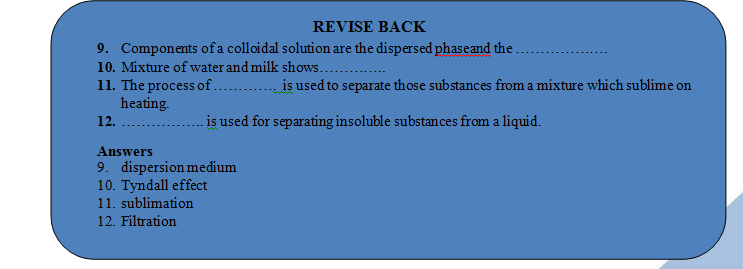
Purification of water
Is matter around us pure of Class 9
River water is normally used to supply drinking water to big cities. This water is unfit for drinking purposes as it contains a large amount of suspended impurities and harmful micro-organisms, such as bacteria and germs. The river water is purified in the following stages -
- Sedimentation tank : The water from river or lake is first passed through the sedimentation tank. During this time, many suspended solids settle down at the bottom of the tank.
- Loading tank: From sedimentation tank, water is sent to the loading tank. In the loading tank, some alum (phitkari) is added to the water. The colloidal particles of clay present in water are negatively charged. They do not settle down in the sedimentation tank. However, when alum is added, these negatively charged particles get neutralized by the positively charged aluminium ions present in alum. In this way, suspended clay particles get loaded with aluminium ions, become heavy and settle down at the bottom of the tank.
- Filtration tank: After the removal of insoluble solids and other suspended impurities, the water is passed through a filtration tank. The filtration tank has three layers. coarse gravel is placed at the bottom of the tank. Above it is placed fine gravel and on the top of gravel is placed a thick layer of fine sand. These layers of sand and gravel act as filters. The impure water is introduced at the bottom. As the water rises above, all the impurities present in water are retained and the pure water leaves the tank at the top.
- Chlorination tank: The water obtained from the filtration tank is introduced into the chlorination tank where it is treated with bleaching powder or some other germicides to kill bacteria.
The water obtained after the above treatments is free from all types of impurities and bacteria and is supplied to our homes for drinking purposes.

Related Topics
🔥 Trending Blogs
Talk to a counsellorHave doubts? Our support team will be happy to assist you!

Check out these Related Articles
Free Learning Resources
PW Books
Notes (Class 10-12)
PW Study Materials
Notes (Class 6-9)
Ncert Solutions
Govt Exams
Class 6th to 12th Online Courses
Govt Job Exams Courses
UPSC Coaching
Defence Exam Coaching
Gate Exam Coaching
Other Exams
Know about Physics Wallah
Physics Wallah is an Indian edtech platform that provides accessible & comprehensive learning experiences to students from Class 6th to postgraduate level. We also provide extensive NCERT solutions, sample paper, NEET, JEE Mains, BITSAT previous year papers & more such resources to students. Physics Wallah also caters to over 3.5 million registered students and over 78 lakh+ Youtube subscribers with 4.8 rating on its app.
We Stand Out because
We provide students with intensive courses with India’s qualified & experienced faculties & mentors. PW strives to make the learning experience comprehensive and accessible for students of all sections of society. We believe in empowering every single student who couldn't dream of a good career in engineering and medical field earlier.
Our Key Focus Areas
Physics Wallah's main focus is to make the learning experience as economical as possible for all students. With our affordable courses like Lakshya, Udaan and Arjuna and many others, we have been able to provide a platform for lakhs of aspirants. From providing Chemistry, Maths, Physics formula to giving e-books of eminent authors like RD Sharma, RS Aggarwal and Lakhmir Singh, PW focuses on every single student's need for preparation.
What Makes Us Different
Physics Wallah strives to develop a comprehensive pedagogical structure for students, where they get a state-of-the-art learning experience with study material and resources. Apart from catering students preparing for JEE Mains and NEET, PW also provides study material for each state board like Uttar Pradesh, Bihar, and others
Copyright © 2025 Physicswallah Limited All rights reserved.
Get App








